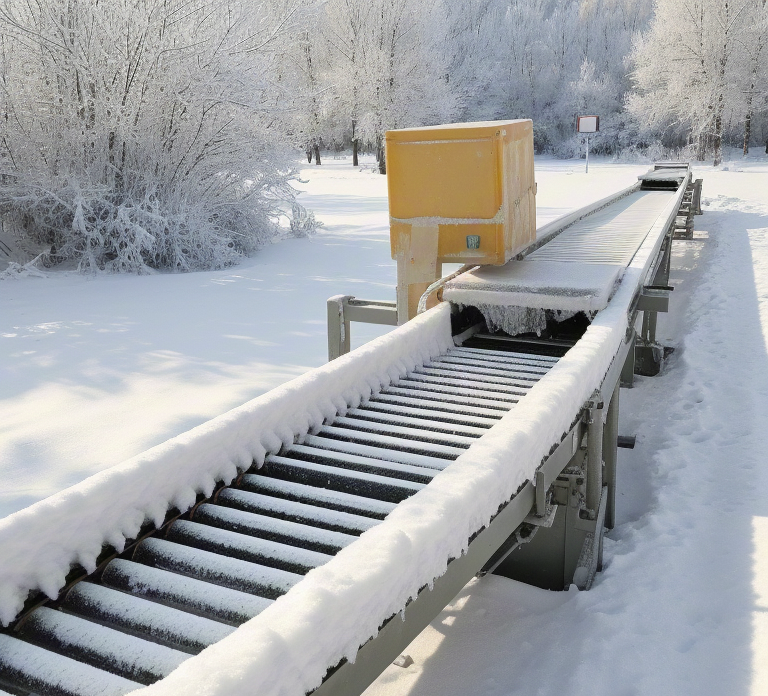
Cold-resistant conveyor belts are an essential component in industries that require material transport in extreme cold environments. These belts ensure that operations remain efficient even in freezing conditions, where standard belts might fail due to temperature-related issues like cracking and brittleness. This guide will provide in-depth information about cold-resistant conveyor belts, their types, applications, design considerations, and much more. This article is ideal for professionals in industries like mining, food processing, agriculture, and logistics, where temperature-controlled systems are crucial.
Table of Contents
- 1. Introduction to Cold-Resistant Conveyor Belts
- 2. Types of Cold-Resistant Conveyor Belts
- 3. Material Properties of Cold-Resistant Conveyor Belts
- 4. Applications of Cold-Resistant Conveyor Belts
- 5. Cold-Resistant Conveyor Belt Design Considerations
- 6. Performance Characteristics in Cold Environments
- 7. Handling Materials Affected by Cold Temperatures
- 8. Maintenance and Care of Cold-Resistant Conveyor Belts
- 9. Factors Affecting Belt Longevity in Cold Environments
- 10. Troubleshooting Cold-Resistant Conveyor Belts
- 11. Case Studies of Cold-Resistant Conveyor Belt Applications
- 12. Conclusion and Future Trends
1. Introduction to Cold-Resistant Conveyor Belts
Cold-resistant conveyor belts are specially designed to transport materials in environments where temperatures are extremely low. These belts are essential for industries that operate in frigid conditions, where standard belts may become brittle, crack, or fail due to low temperatures. Cold-resistant conveyor belts are built to provide flexibility, durability, and resilience in environments where traditional belts would not suffice. They are commonly used in mining, food processing, agriculture, and other industries that operate in cold storage, underground, or refrigeration environments.
2. Types of Cold-Resistant Conveyor Belts
There are various types of cold-resistant conveyor belts available, each designed for specific needs depending on the operating conditions. The choice of belt material depends on the temperature range, environmental factors, and material types being transported.
2.1 Natural Rubber Conveyor Belts
Natural rubber conveyor belts are widely used for moderate cold environments. They offer good flexibility and durability, making them ideal for environments that experience temperatures around freezing point. These belts are commonly used in industries where temperatures do not drop below -20°C.
2.2 Synthetic Rubber Conveyor Belts
Synthetic rubber conveyor belts are made from materials like chloroprene, nitrile, and ethylene propylene diene monomer (EPDM). These belts are engineered to resist cracking and degradation in temperatures as low as -40°C, making them suitable for extremely cold conditions found in industries like mining and logistics.
2.3 PVC and PU Conveyor Belts
Polyvinyl chloride (PVC) and polyurethane (PU) conveyor belts are designed for use in cold storage environments. These belts are not only cold-resistant but also offer properties like easy cleaning and low friction, making them ideal for food processing and packaging industries.
3. Material Properties of Cold-Resistant Conveyor Belts
The material properties of cold-resistant conveyor belts are what make them effective in low-temperature environments. These belts must have characteristics such as flexibility, durability, and resistance to wear and tear. Some key material properties include:
- Flexibility: Cold-resistant belts remain flexible at low temperatures, which prevents them from cracking.
- Durability: These belts are built to resist wear and tear in cold environments, ensuring a long lifespan.
- Cold Resistance: The ability to withstand extreme temperatures without becoming brittle or breaking.
- Chemical Resistance: Protection against oils, chemicals, and other harsh substances.
4. Applications of Cold-Resistant Conveyor Belts
Cold-resistant conveyor belts are used in various industries where materials need to be transported in freezing or below-freezing temperatures. These applications include:
4.1 Mining Industry
In the mining industry, cold-resistant conveyor belts are used to transport ores and minerals in underground mines, where temperatures can drop significantly. These belts are built to withstand the extreme cold encountered in deep mines.
4.2 Food Processing and Packaging
Cold-resistant conveyor belts are crucial in food processing plants, particularly those that deal with frozen foods. The belts help maintain the integrity of materials like frozen vegetables, meat, and seafood while ensuring smooth and hygienic transportation.
4.3 Agriculture and Farming
In agricultural operations, cold-resistant conveyor belts are used to handle harvested crops like potatoes, carrots, and other vegetables, which are stored and transported in cold storage units.
4.4 Logistics and Warehousing
Cold-resistant conveyor belts are essential in logistics and warehousing, especially in distribution centers for frozen goods. They ensure that materials are moved efficiently in refrigerated environments without risk of breakdowns.
5. Cold-Resistant Conveyor Belt Design Considerations
When designing a cold-resistant conveyor belt, several factors must be considered to ensure optimal performance. These include:
- Material Selection: Choosing the right rubber or polymer to withstand cold temperatures.
- Thickness: The thickness of the belt influences its ability to resist freezing and maintain flexibility.
- Coating and Treatments: Protective coatings can improve the belt's resistance to cold and wear.
6. Performance Characteristics in Cold Environments
Cold-resistant conveyor belts need to perform under challenging conditions. Key performance characteristics include:
- Temperature Flexibility: The belt should remain flexible even at extremely low temperatures.
- High Durability: The belt must be able to resist wear, abrasions, and damage caused by cold handling.
- Efficiency: Cold-resistant belts ensure smooth operations in freezing environments, maintaining efficiency and speed.
12. Conclusion and Future Trends
Cold-resistant conveyor belts play a vital role in various industries that require material handling in freezing environments. As technology advances, the materials and design of these belts continue to improve, offering better performance and longer lifespans. The future of cold-resistant conveyor belts looks promising, with innovations aimed at enhancing their durability, flexibility, and resistance to cold. As industries continue to expand into colder regions, the demand for advanced cold-resistant belts will only increase.

